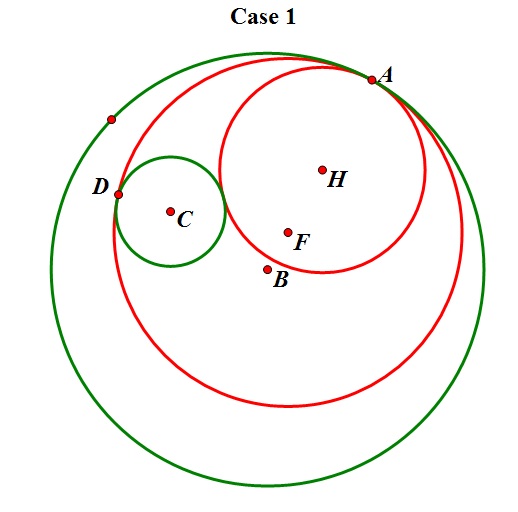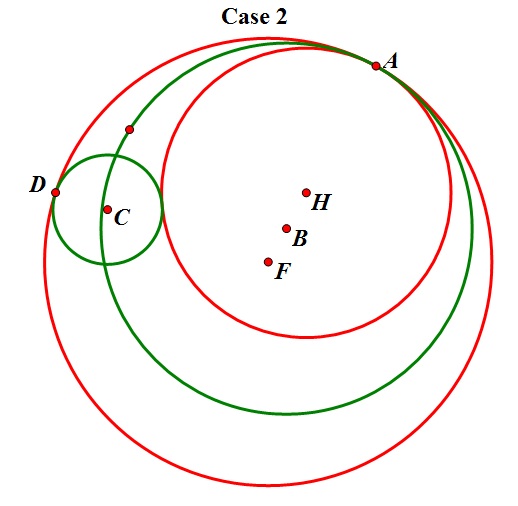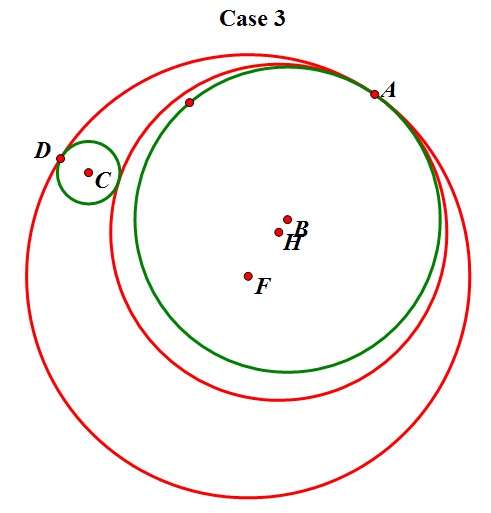

Write Up 7:
Tangent Circle Construction & Script Tool
Zachary Laughlin
Introduction:
Throughout this write up, we will be discussing how to construct tangent circles and looking at their properties within three different cases. These cases can be seen below:



Case 1: The smaller circle centered at point C lies within the bigger circle centered at point B.
Case 2: The smaller circle C and the bigger circle B intersect with each other.
Case 3: The smaller circle C and the bigger circle B are disjoint and do not touch
The Construction:
For this construction, lets first construct the tangent circle seen in case 1 and then GSP will allow us to manipulate the green circle to see case 2 and case 3.
Step 1: We create two circles. One smaller circle lies within a bigger circle. The smaller circle is centered at C and the bigger circle is centered at B. We will call these circles C and B for future reference. We will also plot an arbitrary point of tangency A where the two tangent circles will eventually meet. See below:
Step 2: Now in order to construct a tangent circle that is tangent to both circle C and circle B, we have to find the center of the tangent circle. Lets call this tangent circle X. Hence, the center of tangent circle X must lie on the line through point A and B. Eventually we will see that we need this center of circle X to be equidistant from point A and point C. Lets see what we have so far:
Step 3: Now we must construct a circle centered at point A that has the same radius as circle C centered at point C. This is the trick that can give us the point that lies equidistant from point C and point A. By using tools in GSP, we can construct a circle centered at point A with the radius of length CD. Therefore, the circle centered at point A will have a length AF which is equal to length CD. Now we must construct a line segment from the point F, which lies on line AB and also lies on circle A, to the center of circle C which is point C. See below what it looks like in GSP.
Step 4: Now that we have the line segment FC, we can find the point that lies equidistant from points A and C. Next we must construct the midpoint of line segment FC and then drop the perpendicular of line segment FC through the midpoint. We will get an intersection point through line AB and this will be the point in which we center our first tangent circle around. This tangent circle will have radius of length XA. See below:
Step 5: Now we need to construct the outer tangent circle, which is also tangent to both circles C and B. The construction of this outer tangent circle is very similar to the one we just constructed. In the construction of the first tangent circle X, we used the point F which lies on circle A and is also one of the intersection points of circle A and line AB. In order for use to construct the outer tangent circle, we will use the other intersection point of circle A and line AB. We will call this point G. After we have point G, we can construct a line segment from point G to point C and find its midpoint. See below:
Step 6: Similarly, we can construct a perpendicular line through the midpoint of the line segment GC. This perpendicular line will intersect line AB at some point, call it point Y. Point Y will be the center of our outer tangent circle. This outer tangent circle will have radius YA. See finished construction below:
One Step Further:
Now we have constructed two circles X and Y which are tangent to both circles C and B. In order to explore the different cases mentioned earlier in the write up, I have made a link of my GSP file "Tangent Circles." Use this GSP file to investigate the behavior of the tangent circles when circles B and C are intersected and when they are disjointed. Also GSP allows for a wonderful trace tool which allows you to see the trace of any point in the construction. Below I will show you the trace of point A and C. What kind of figure is created by this trace?
CLICK GSP Link "TANGENT CIRCLES"